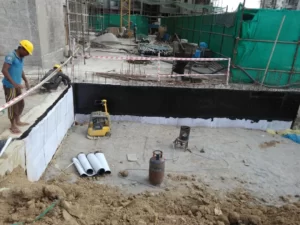1.SBS Self Adhesive Waterproofing Membrane – HDPE Cross laminated
Description:
SBS self-adhesive waterproofing membrane is a type of roofing or waterproofing material that is made from a blend of styrene-butadiene-styrene (SBS) and high-quality bitumen. The membrane is designed to be self-adhesive, which means it can be easily applied to a variety of surfaces without the need for additional adhesive.
The SBS self-adhesive HDPE Cross laminated waterproofing membrane is typically composed of a flexible and durable HDPE cross laminated layer, which is coated with a layer of SBS-modified bitumen. The bottom of the membrane is protected by a release liner/film, which is removed before application to reveal the adhesive layer.






This type of membrane is highly flexible, making it suitable for use on irregular or curved surfaces. It also has excellent adhesion properties, which allows it to bond strongly to a variety of substrates, including concrete, metal, and wood.
Uses of SBS Self Adhesive Waterproofing Membrane:
- Foundations: The membrane can be used to waterproof and damp proofing foundations and basements, protecting them from moisture and water infiltration.
- It may be used for horizontal and vertical application and as a damp proofing course for tanking below ground structures, retaining walls etc.
- Tunnels: The membrane is also used in the construction of tunnels and underground structures, providing a reliable and durable waterproofing solution.
- Bridges: The membrane can be used to protect bridge decks from water damage and corrosion, extending the life of the bridge structure.
- Landscaping: The SBS self adhesive HDPE Cross laminated membrane can be used in landscaping projects, such as green roofs or planter boxes, to prevent water from penetrating the structure and causing damage.




Application Instructions for SBS Self Adhesive Waterproofing Membrane
General application procedures for installing SBS self-adhesive waterproofing membrane – HDPE cross-laminated:


- Surface preparation: The surface to be waterproofed must be clean, dry, and free of any contaminants, such as dust, oil, grease, or loose debris. Any rust, scale, or other corrosion must be removed by abrasive blasting, grinding, or other suitable methods.
- Primer application: A primer should be applied to the surface to be waterproofed, as per the manufacturer’s instructions. The primer should be allowed to dry completely before proceeding to the next step.
- Membrane installation: Roll out the SBS self-adhesive waterproofing membrane – HDPE cross-laminated on the prepared surface, ensuring that it is aligned and positioned correctly. Carefully remove the release liner from the membrane, and press the adhesive side onto the surface, starting from the center and working towards the edges. Use a pressure roller to ensure good adhesion and to eliminate any air pockets.
- Sealing: To ensure maximum protection against water infiltration, all seams, joints, and overlaps in the membrane should be sealed using a suitable sealant or tape.
- It is important to follow the manufacturer’s instructions regarding specific application procedures and equipment, as they may vary depending on the specific product and the conditions of the installation site.




Protection layer for SBS Self Adhesive Waterproofing Membrane:
Depending on the application, a protection layer may be required to protect the membrane from damage due to UV radiation, mechanical stress, or other factors. This may include a layer of insulation, a ballast layer, or a layer of soil or vegetation in the case of green roofs.
The membrane shall be protected immediately after application from damage, due to ongoing site activities or from sharp aggregates during backfilling by a HDPE dimpled protection board. On horizontal areas, the membrane can also be protected by laying a cement sand screed (50 mm).




SBS membranes can also be classified based on the lamination method used to reinforce them. Here are some common variants of SBS membranes based on lamination:
- HDPE Cross-Laminated SBS Membrane: This type of membrane is reinforced with a layer of high-density polyethylene (HDPE) that is cross-laminated with a layer of SBS modified bitumen. This provides superior strength, durability, and dimensional stability, making it suitable for use in high-stress applications.
- APP Modified SBS Membrane: While not technically an SBS membrane, this type of membrane is similar in composition and is often used in conjunction with SBS membranes. It is made with a blend of atactic polypropylene (APP) and SBS modified bitumen, which provides excellent durability and resistance to UV radiation.
- SBS membrane with Aluminum foil: SBS membranes with aluminum foil are a type of SBS membrane that is reinforced with a layer of aluminum foil on one side. The aluminum foil serves as a reflective barrier that helps to reflect sunlight and heat away from the building, which can help to reduce the cooling load and energy costs. The aluminum foil layer is typically laminated to a layer of SBS modified bitumen, which provides excellent waterproofing and flexibility. SBS membranes with aluminum foil are commonly used in roofing applications, particularly in warm climates where heat gain is a concern.
GEOLIZ WATERPROOFERS PVT. LTD.
Waterproofing Products & Services Guide
For details on other waterproofing products & Services
